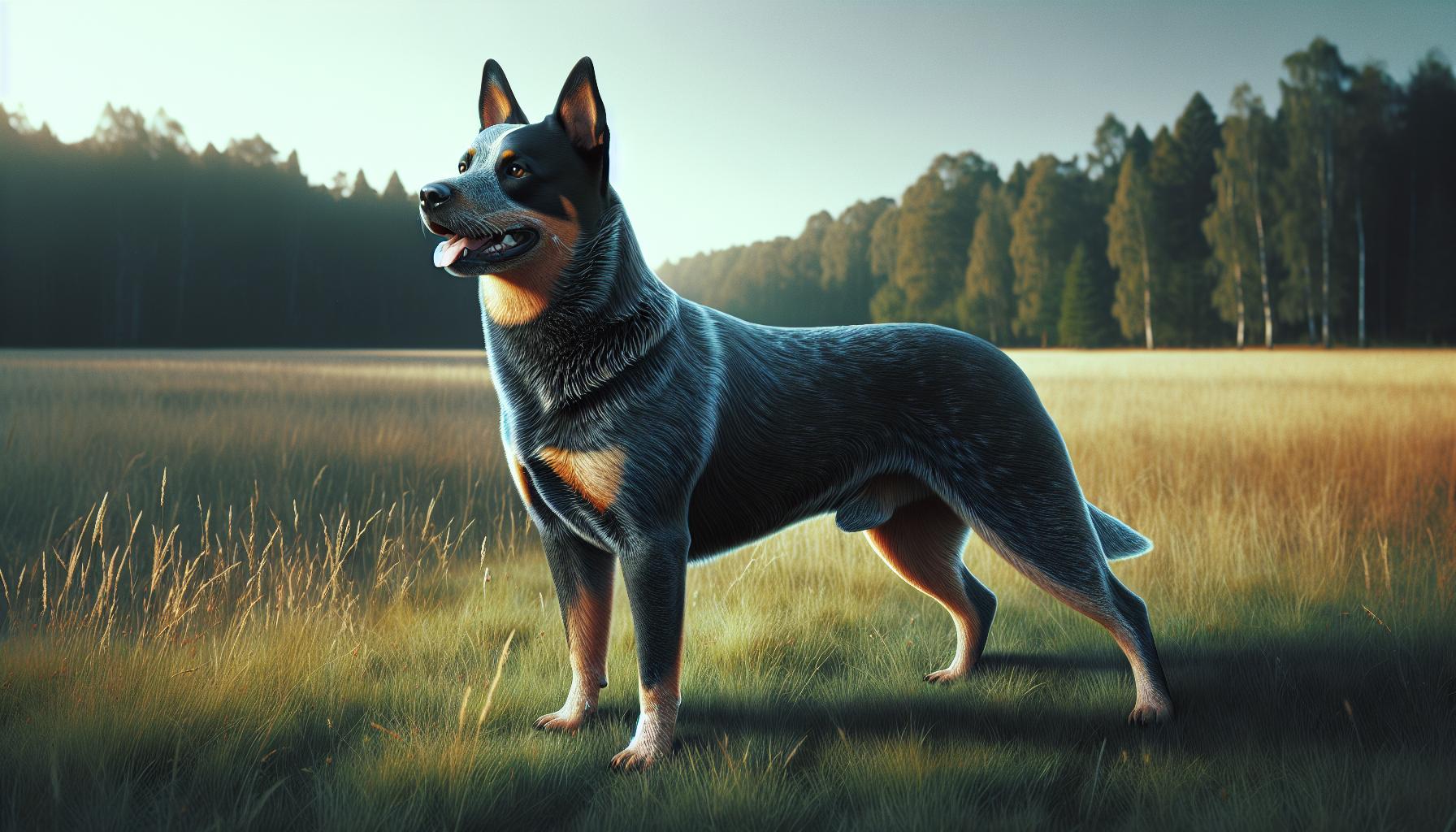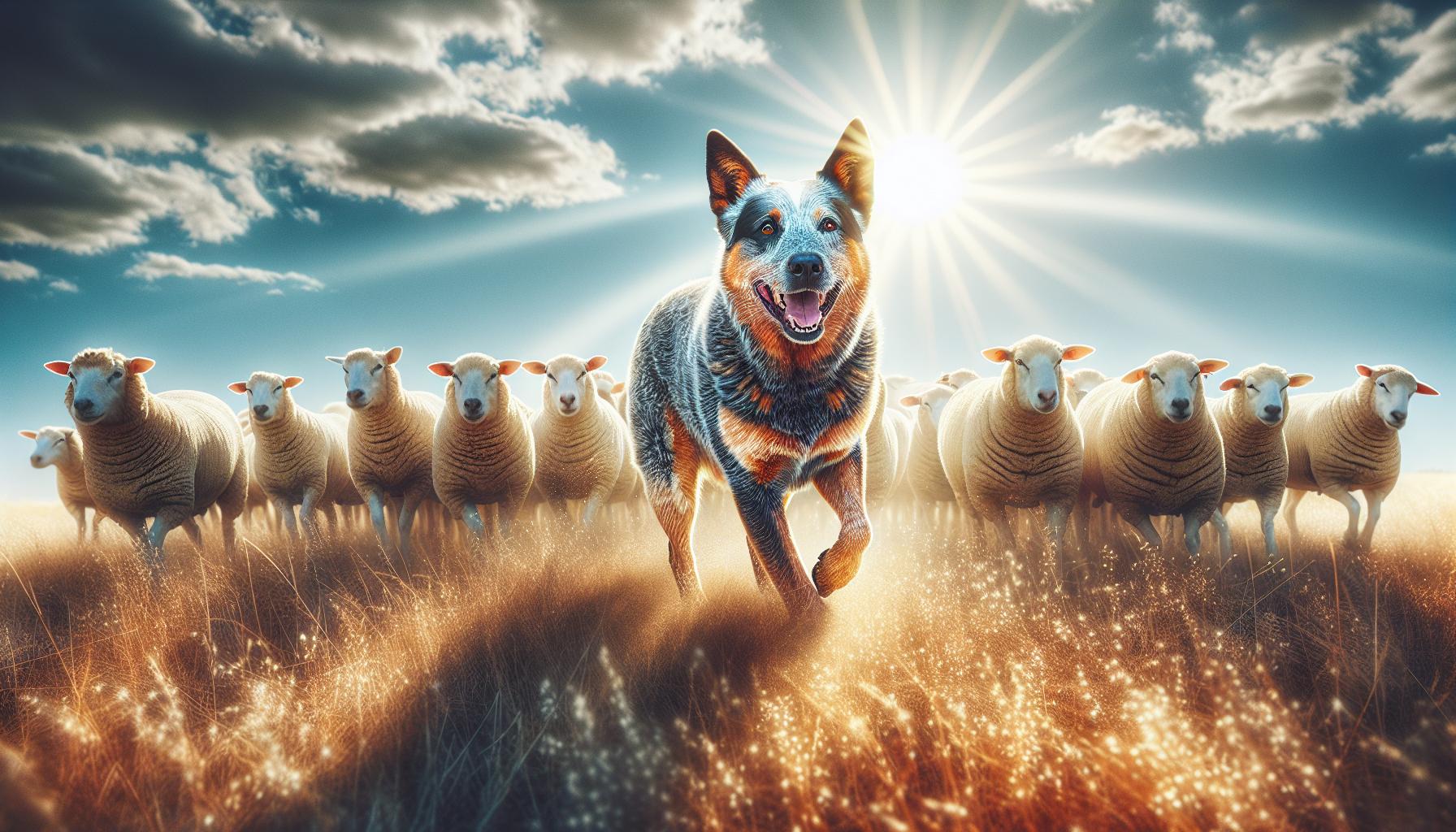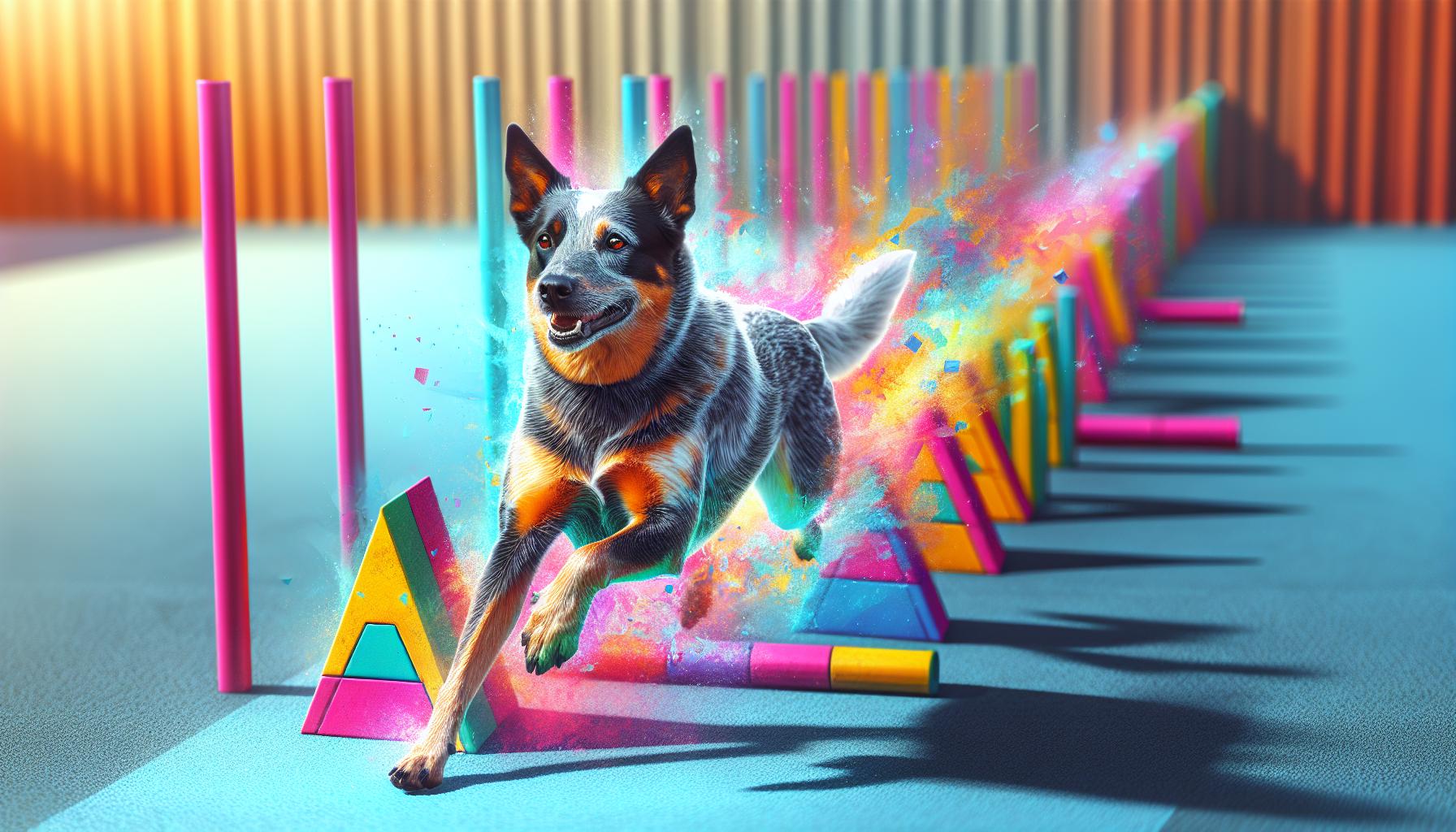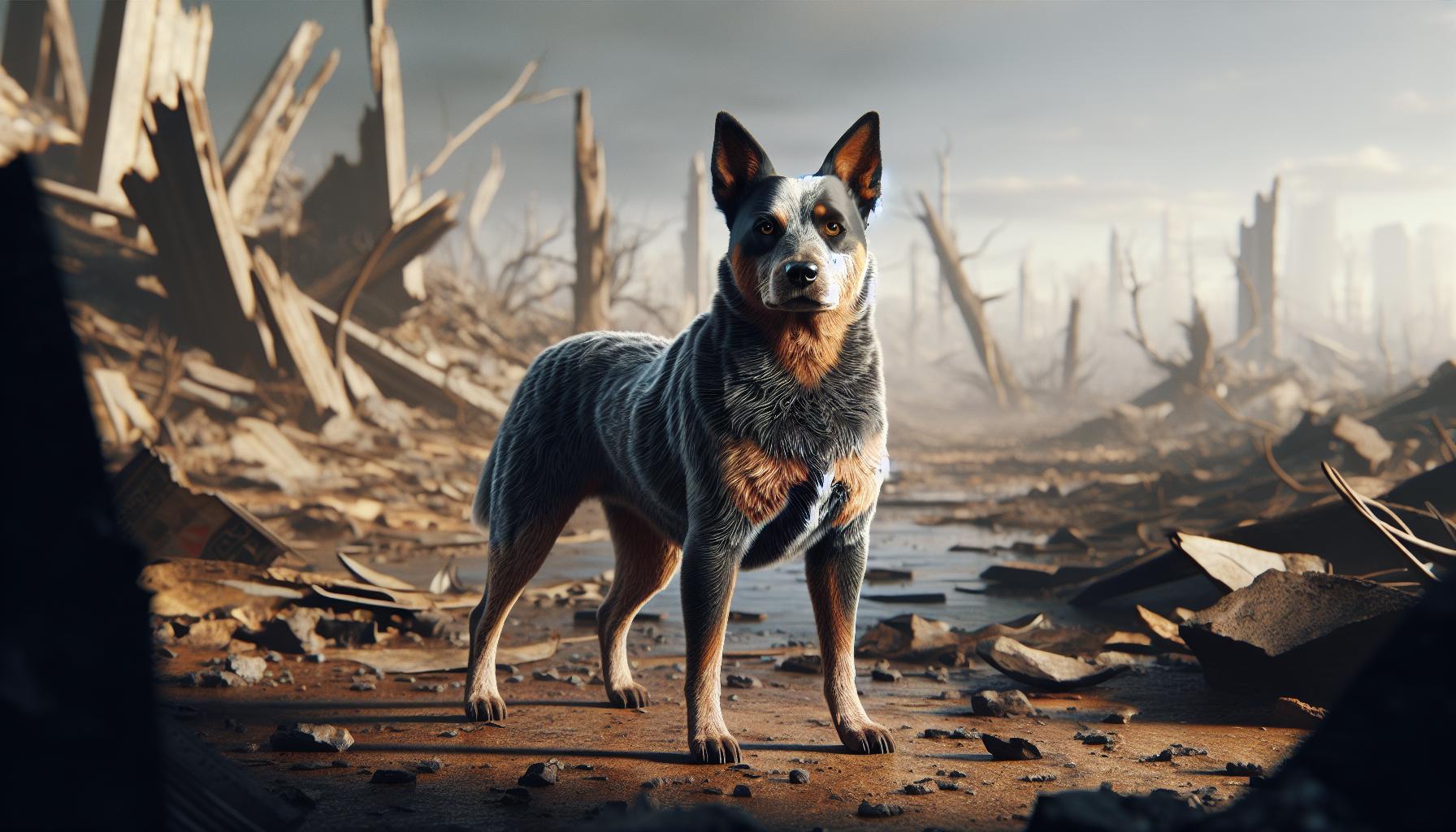I’ve always been fascinated by the iconic dog from the Mad Max films, particularly the Australian Cattle Dog that captured viewers’ hearts in “Mad Max 2: The Road Warrior.” This intelligent and loyal breed, also known as the Blue Heeler, played a crucial role alongside Max Rockatansky in the post-apocalyptic wasteland.
As a long-time dog enthusiast, I can tell you that Australian Cattle Dogs aren’t just movie stars – they’re exceptional working dogs with remarkable herding abilities and unwavering loyalty. After researching their history and characteristics, I’ve discovered why director George Miller chose this specific breed to be Max’s faithful companion in the harsh outback setting.
Key Takeaways
- The Mad Max dog breed is an Australian Cattle Dog (Blue Heeler), known for its intelligence, loyalty, and exceptional herding abilities
- Blue Heelers were developed in 1800s Australia by crossing British Smithfields, Dingoes, Scottish Highland Collies, and Dalmatians to create the perfect cattle herding dog
- The breed features a distinctive speckled coat (blue or red), muscular build, and weighs 30-50 pounds, standing 17-20 inches tall
- Australian Cattle Dogs need 2-3 hours of daily exercise, consistent mental stimulation, and early socialization to manage their high-energy working dog temperament
- Common health concerns include hip dysplasia, progressive retinal atrophy, and deafness, requiring regular veterinary screenings
- The breed gained fame through “Dog” in Mad Max 2: The Road Warrior (1981), showcasing their natural protective instincts and rugged resilience
What Is the Mad Max Dog Breed
The Mad Max dog breed is an Australian Cattle Dog, also known as a Blue Heeler. I recognize this intelligent herding breed from its distinctive appearance and working capabilities displayed in the film series.
Origin of the Blue Heeler Breed
The Australian Cattle Dog emerged in the 1800s when colonists needed a hardy dog to manage cattle in Australia’s harsh conditions. These dogs resulted from crossing imported British Smithfields with Dingoes, Scottish Highland Collies and Dalmatians. Thomas Hall developed the breed at his property in New South Wales, creating dogs with:
- Blue or red speckled coats
- Strong muscular bodies
- Natural herding instincts
- High stamina for long-distance work
- Protective temperaments
Role in the Mad Max Films
The Blue Heeler appears as “Dog” in Mad Max 2: The Road Warrior (1981), serving as Max’s loyal companion. The dog’s role includes:
- Acting as a protective guardian for Max
- Alerting to danger in the wasteland
- Fighting alongside Max against raiders
- Demonstrating the breed’s natural defensive abilities
- Contributing to key plot developments through its actions
| Characteristic | Display in Film |
|---|---|
| Intelligence | Strategic warning behaviors |
| Loyalty | Unwavering dedication to Max |
| Agility | Quick combat movements |
| Endurance | Survival in harsh conditions |
| Protectiveness | Defense against threats |
Physical Characteristics of Australian Cattle Dogs

Australian Cattle Dogs display distinctive physical traits that reflect their working heritage. These compact yet powerful dogs possess a balanced build designed for endurance and agility.
Size and Build
Australian Cattle Dogs feature a muscular medium-sized frame with males standing 18-20 inches tall at the shoulder while females measure 17-19 inches. Adult dogs maintain a healthy weight between 30-50 pounds depending on gender. Their sturdy build includes:
- Broad chest with deep ribcage
- Strong muscular shoulders for herding
- Level topline from withers to tail
- Well-developed thighs for bursts of speed
- Oval-shaped feet with compact toes
- Blue variety:
- Black mottled or speckled pattern
- Tan markings on legs face & chest
- Dark patches on both sides of body
- Red variety:
- Even red speckles across body
- Dark red markings on head
- White spots permitted on chest
Both color varieties feature: - Dense double coat texture
- Short weather-resistant outer layer
- Soft undercoat for insulation
- Distinctive mask around eyes
- Balanced symmetrical markings
Temperament and Personality Traits

Australian Cattle Dogs display complex personality traits shaped by their working heritage. Their temperament combines intelligence, loyalty, and strong protective instincts that make them exceptional companions.
Working Dog Intelligence
The Australian Cattle Dog’s intelligence ranks among the top 10 smartest dog breeds. These dogs excel at:
- Learning new commands in 5-15 repetitions
- Responding to first-time commands with 95% accuracy
- Mastering complex tasks like advanced obedience, agility training, or herding routines
- Problem-solving through independent thinking
- Adapting to changing situations or environments quickly
Their mental capabilities require:
- Daily cognitive stimulation through puzzle toys or training exercises
- Regular mental challenges to prevent destructive behavior
- Structured training sessions lasting 15-20 minutes
- Complex tasks that engage their problem-solving abilities
Herding Instincts
The Australian Cattle Dog’s herding traits manifest in specific behaviors:
- Circling and nipping at moving objects or people
- Maintaining constant awareness of their surroundings
- Exhibiting strong eye contact and stalking movements
- Responding instinctively to fast-moving objects
- Demonstrating territorial control in defined spaces
These instincts translate into:
- Natural boundary patrolling
- Quick responses to unusual movements
- Strategic positioning to control group movement
- Persistent focus on tasks until completion
- Protective behaviors toward family members
- Early socialization with children and other pets
- Structured outlets for herding energy
- Regular exercise spanning 1-2 hours daily
- Consistent training to manage nipping behaviors
- Designated jobs or tasks to fulfill their working drive
Training and Exercise Requirements

Australian Cattle Dogs maintain peak physical and mental fitness through intensive daily activities. Their working heritage creates a high-drive personality that requires constant engagement.
Mental Stimulation Needs
I incorporate puzzle toys, herding exercises and obedience training into daily routines to satisfy their cognitive demands. Australian Cattle Dogs excel at:
- Learning advanced commands through 15-20 minute training sessions
- Completing food puzzles that challenge problem-solving abilities
- Participating in agility courses with increasing complexity
- Engaging in scent work activities for 30-45 minutes
- Mastering new tricks through positive reinforcement training
Physical Activity Level
I ensure these dogs receive 2-3 hours of vigorous exercise daily to maintain their wellbeing. Their exercise routine includes:
- High-intensity running sessions covering 3-5 miles
- Structured herding activities for 45-60 minutes
- Swimming laps for 30 minutes in warm weather
- Fetch games incorporating directional commands
- Hiking on varied terrain for 1-2 hours
| Activity Type | Duration | Frequency |
|---|---|---|
| Cardio | 60-90 mins | Daily |
| Strength | 30-45 mins | 3x weekly |
| Agility | 45-60 mins | 2x weekly |
| Mental Work | 30 mins | Daily |
Health and Care Considerations
Australian Cattle Dogs require specific healthcare attention to maintain their robust working abilities. I’ve identified several crucial health aspects that demand regular monitoring:
Common Health Issues
- Hip Dysplasia: Affects 10% of the breed population
- Progressive Retinal Atrophy (PRA): Emerges between ages 3-5
- Deafness: Present in 2.4% of blue-speckled variants
- Joint Problems: Including elbow dysplasia arthritis
| Health Screening | Recommended Age | Frequency |
|---|---|---|
| Hip Evaluation | 24 months | Once |
| Eye Examination | 12 months | Annually |
| Hearing Test | 6 weeks | Once |
| Joint Assessment | 24 months | Annually |
Grooming Requirements
- Brush coat weekly to remove loose fur debris
- Bathe every 4-8 weeks using dog-specific shampoo
- Clean ears bi-weekly to prevent infections
- Trim nails every 2-3 weeks
- Check paw pads after intense activities
Nutritional Needs
- Feed 2-3 cups of high-protein dry food daily
- Divide meals into 2 portions: morning evening
- Include 25-30% protein content for working dogs
- Add omega-3 supplements for coat joint health
- Maintain fresh water access throughout day
- Schedule veterinary checkups every 6 months
- Update vaccinations based on regional requirements
- Maintain monthly parasite prevention
- Monitor weight quarterly
- Document behavioral changes promptly
These care considerations align with the breed’s high-energy working background while ensuring optimal health maintenance. Blue Heelers living in urban environments need additional attention to their exercise nutrition requirements to prevent obesity related health issues.
Famous Blue Heelers in Film History
“Dog” from Mad Max 2: The Road Warrior stands as the most iconic Blue Heeler in cinema history. The character, played by an Australian Cattle Dog named “Dog,” appeared alongside Mel Gibson in the 1981 post-apocalyptic film. Director George Miller selected the breed for its natural protective instincts and rugged appearance that matched the film’s dystopian setting.
Red Dog, based on the true story of a Red Heeler in Western Australia, showcases another notable Blue Heeler in film. The 2011 movie features Koko, a Red Heeler who portrays the legendary wandering dog that united mining communities in the Pilbara region during the 1970s.
Notable Blue Heeler appearances in television include:
- Sophie from “Bluey” (2018-present) – A Blue Heeler mother in the acclaimed animated series
- Bandit from “Bluey” (2018-present) – A Blue Heeler father character voiced by David McCormack
- Mick from “McLeod’s Daughters” (2001-2009) – A working cattle dog essential to the ranch operations
Here’s a breakdown of significant Blue Heeler film appearances:
| Film Title | Year | Dog’s Name | Role Description |
|---|---|---|---|
| Mad Max 2 | 1981 | Dog | Post-apocalyptic survivor companion |
| Red Dog | 2011 | Koko | Wandering community mascot |
| Babe | 1995 | Multiple | Working farm dogs |
These cinematic portrayals highlight the breed’s versatility, from action-packed survival scenarios to heartwarming community tales. Each representation reinforces the Blue Heeler’s reputation for intelligence, loyalty, and adaptability across different film genres.
Conclusion
The Australian Cattle Dog’s starring role in Mad Max perfectly captures this breed’s exceptional qualities. I’ve found that their intelligence loyalty and fierce protective nature make them outstanding companions for the right owners. While they need significant exercise and mental stimulation these dogs will reward dedicated handlers with unwavering devotion.
I believe anyone considering a Blue Heeler should carefully evaluate their lifestyle to ensure they can meet this breed’s substantial needs. When properly trained and cared for these remarkable dogs prove why they’re celebrated both on-screen and as beloved family members.

